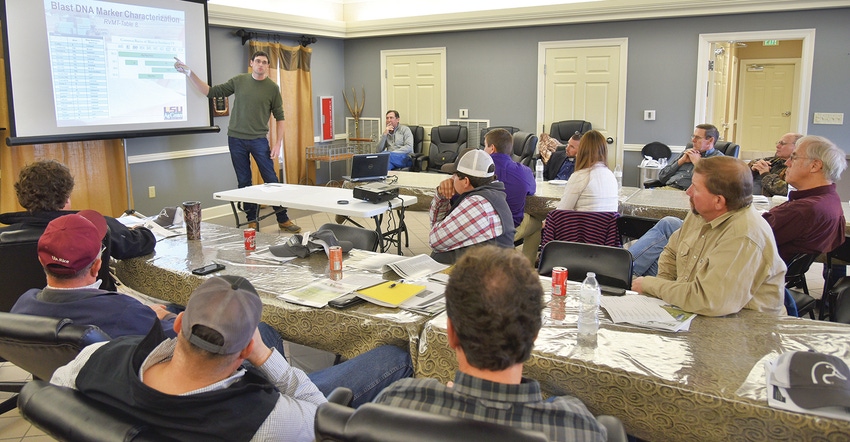January 23, 2018

The first part of an annual series of LSU AgCenter meetings for rice farmers in south Louisiana wrapped up in early January. Scientists from the AgCenter H. Rouse Caffey Rice Research Station made presentations in Crowley, Welsh, Abbeville and Ville Platte. Additional meetings were scheduled for Avoyelles, Richland and St. Martin parishes.
Much of the attention was on Provisia rice and its companion herbicide of the same name.
AgCenter rice breeder Adam Famoso said work is under way to develop improved Provisia varieties. A new line, PVL08, has an improved yield in both the first and second crop compared with the first line released as a variety, PVL01.
Getting a new conventional long-grain variety is a priority of the breeding program, he said. The hybrid breeding program has several promising lines, and increasing and testing a number of hybrids are priorities.
The new Clearfield Jazzman variety to be released this year has higher yield potential with excellent grain quality, including low chalk, Famoso said.
Kellogg recently tested the variety CL272 with favorable results for use in the company’s products, but more tests are required. “We just got word yesterday that their first plant run was positive,” Famoso said in Evangeline Parish.
AgCenter agronomist and Extension rice specialist Dustin Harrell said Provisia will help return some rice acreage to production after being plagued with Clearfield-resistant offtypes and weedy rice.
Provisia has the distinction of having a lighter green color, regardless of the amount of nitrogen fertilizer used. Nitrogen in the range of 150-180 pounds per acre will be needed, Harrell said.
Provisia herbicide
AgCenter weed scientist Eric Webster said the Provisia herbicide will be the best grass herbicide for rice. It can cause slight injury to young rice especially if the application is followed by cloudy conditions, but the crop will recover.
He cautioned farmers about tank-mixing other herbicides with Provisia, recommending against Grasp and Regiment. “Probably the worst thing you can tank mix is propanil,” Webster said.
The Provisia herbicide, if tank-mixed with another herbicide, should be applied immediately, and a good-quality crop oil is recommended, he said.
Provisia use should be limited to fields with bad herbicide-resistant problems. “I would put it on my worst fields,” Webster said.
AgCenter plant pathologist Don Groth said fungicide research at the Rice Research Station is showing good potential for a ratoon crop treated for disease. The best results are from an application made five weeks after harvest. However, only one fungicide is labeled for ratoon crop application, and stubble management can be more effective and economical.
AgCenter entomologist Blake Wilson said targeting adult rice water weevils with an application of a pyrethroid insecticide can be less expensive than using a seed treatment, but a second application may be required. And the pyrethroid option has the disadvantage of being incompatible with crawfish.
Dermacor seed treatments
Dermacor seed treatments provide excellent control of both weevils and stem borers, Wilson said. But widespread use of this product has led to concerns about development of insecticide resistance. Diversification of management strategies, including the use of alternative seed treatments, is needed to delay resistance and prolong the effectiveness of seed treatments.
Some Texas farmers have been mixing pyrethroids with a fungicide to treat rice for borer insects, he said.
AgCenter economist Mike Deliberto said a 700,000-acre decline in harvested rice acres last year helped boost prices.
U.S. exports were down in 2016 by 15 percent, but imports increased by 3.8 percent, mostly from India and Thailand, he said. Increased export demand is needed to support prices long-term, but currently tight supplies are supporting prices now.
The U.S. Department of Agriculture projects the long-grain price at $11.60 to $12.60 per hundredweight, or around $19.60 a barrel. But the price is dependent on the amount of acreage planted in Arkansas this year, Deliberto said.
“The only thing certain is there’s going to be a lot of uncertainty,” he said.
Soybeans
AgCenter soybean specialist Todd Spivey said most of the problems soybean farmers experienced last year were out of their control. He said research is planned for optimizing late-planted beans.
The results from AgCenter variety testing should be used to help with choosing soybean varieties, but Spivey cautioned against using data from only one location.
AgCenter entomologist Jeff Davis said this winter’s cold weather should help control redbanded stink bugs. The insect is vulnerable with 10 hours of temperature at 23 degrees. “I’m sure the last four or five days have been at least 23 degrees,” he said.
About the Author(s)
You May Also Like




